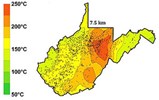SMU Geothermal Mapping Project Reveals Large, Green Energy Source In Coal Country

New research produced by Southern Methodist University's Geothermal Laboratory, funded by a grant from Google.org, suggests that the temperature of the Earth beneath the state of West Virginia is significantly higher than previously estimated and capable of supporting commercial baseload geothermal energy production.
Geothermal energy is the use of the Earth's heat to produce heat and electricity. "Geothermal is an extremely reliable form of energy, and it generates power 24/7, which makes it a baseload source like coal or nuclear," said David Blackwell, Hamilton Professor of Geophysics and Director of the SMU Geothermal Laboratory.
The SMU Geothermal Laboratory has increased its estimate of West Virginia's geothermal generation potential to 18,890 megawatts (assuming a conservative 2% thermal recovery rate). The new estimate represents a 75 percent increase over estimates in MIT's 2006 "The Future of Geothermal Energy" report and exceeds the state's total current generating capacity, primarily coal based, of 16,350 megawatts.
The West Virginia discovery is the result of new detailed mapping and interpretation of temperature data derived from oil, gas, and thermal gradient wells – part of an ongoing project to update the Geothermal Map of North America that Blackwell produced with colleague Maria Richards in 2004. Temperatures below the Earth almost always increase with depth, but the rate of increase (the thermal gradient) varies due to factors such as the thermal properties of the rock formations.
SOURCE: Southern Methodist University
